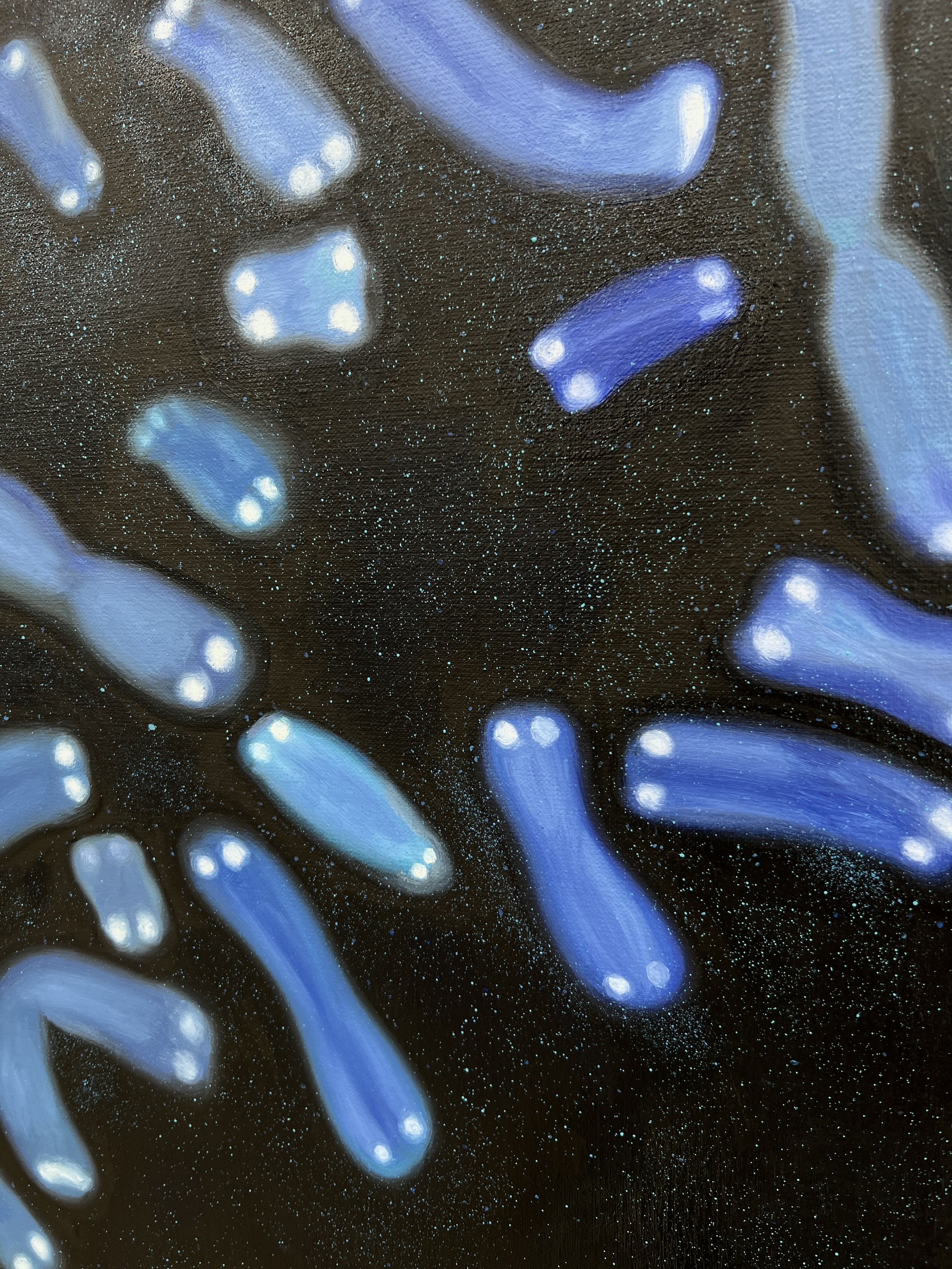Chromosomes, 2022
Chromosomes, 2022
Oil on linen
102 x 91 cm (40 x 36 in)
Historically, sequencing the human genome as "complete" has always been a relative term. The first human genome, deciphered through the Human Genome Project (HGP) in October 1990, was a thirteen-year effort that covered most protein-coding regions but left approximately 8% of the genome unexplored. On March 31, 2022, nearly 100 scientists from the Telomere-to-Telomere (T2T) Consortium finally mapped the first objectively complete human genome.
Tan Mu examines this groundbreaking scientific milestone through the inherently interpretive and the hand-painting uncertainty of the painting medium in Chromosomes (2022). By rendering the 46 human chromosomes and their telomeres in delicate blue and white hues, the unique nature of painting contrasts with the supposed 'completeness' of the genome. This contrast emphasizes that the achievement of painting chromosomes marks the beginning of more profound research into human nature and the potential discovery of its differences from other species.
Q: How do you understand the characteristic of "uncertainty" you mentioned about painting?
Tan Mu: This concept refers to the unique "hand-painting quality" of painting, which inherently carries a sense of uncertainty. In contrast, a printed lab image is a direct and precise reproduction. The hand-painted process, however, differs fundamentally from the perfect replication of an image through printing; it is never a hundred percent reproduction. This characteristic embodies the handmade quality, which reflects the individuality and unique creative process behind each work.
Through this quality, I explore the concept of decoding the genome, echoing the imperfections of the initial attempts at gene sequencing in 1991. I remember seeing a basic representation of decoded DNA in the news and textbooks as a child. Given the technology of the time, it was a relatively rough version. Only recent scientific breakthroughs have resulted in a more complete representation of the genome. Though there might still be error margins, it’s a significant step forward. Companies like AlphaFold are now using AI to decode protein structures, advancing this field even further. From this perspective, the "uncertainty" in painting not only reflects the uniqueness of the artistic process but also parallels the trajectory of technological development.
Q: How do you perceive the scientific progress of achieving a relatively complete chromosome staining pattern, and how does it relate to your creative themes?
Tan Mu: This directly corresponds to my earlier work, IVF (2020). These technologies aim to decode the DNA structure that defines us. On one hand, this progress holds the potential to treat diseases, enabling early interventions for conditions like cancer, which might one day be curable. Decoding proteins at the genetic level also opens the door to personalized medicine.
The advancements in decoding DNA and proteins represent pivotal technologies in humanity's pursuit of transcending life and death. My art responds to these scientific developments. This particular painting was created just two days after the publication of a groundbreaking paper on the first objectively complete human genome. When I saw the news, I was immediately reminded of earlier reports from my childhood about efforts to decode DNA. It struck me as a major milestone—an idea that had once seemed distant and speculative finally realized. It felt like tying a significant knot in the timeline of scientific discovery.
In this sense, my work functions like a form of knot-tying, recording key moments in history. Through my art, I emphasize the timeliness of creation, documenting breakthroughs that mark critical points in human progress. These reflections express my deep and ongoing concern about the relationship between technology and human destiny.
Q: What artistic techniques did you use in this painting to convey your ideas?
Tan Mu: If you look closely at the painting, the background is filled with tiny blue dots. These dots were created using a technique similar to what I employ in my depictions of starry skies and cosmic scenes. I enjoy using points as a means of expression—they are not merely visual elements but carry symbolic meaning.
During the creation process, I rendered the small dots found in scientific images with greater clarity and intensity, giving them a more striking presence. While the original image contained some dots, I added more detail, and the finished work evokes an effect reminiscent of a starry sky or bioluminescent organisms deep beneath the ocean. These dots are not only a demonstration of artistic technique but also connect to other themes in my work, such as the starry dots in the Signal series exhibited in Berlin or the white noise dots in data visualizations.
These dots symbolize a universal connectivity. From both an artistic and conceptual perspective, they reflect my fascination with information and data—how they generate meaning across different contexts, from the microscopic to the macroscopic.





